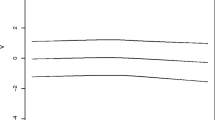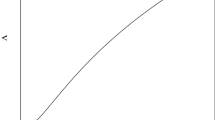Abstract
When sample sizes are unequal, problems of heteroscedasticity of the variables given by the absolute deviation from the median arise. This paper studies how the best known heteroscedastic alternatives to the ANOVA F test perform when they are applied to these variables. This procedure leads to testing homoscedasticity in a similar manner to Levene’s (1960) test. The difference is that the ANOVA method used by Levene’s test is non-robust against unequal variances of the parent populations and Levene’s variables may be heteroscedastic. The adjustment proposed by O’Neil and Mathews (Aust Nz J Stat 42:81–100, 2000) is approximated by the Keyes and Levy (J Educ Behav Stat 22:227–236, 1997) adjustment and used to ensure the correct null hypothesis of homoscedasticity. Structural zeros, as defined by Hines and O’Hara Hines (Biometrics 56:451–454, 2000), are eliminated. To reduce the error introduced by the approximate distribution of test statistics, estimated critical values are used. Simulation results show that after applying the Keyes–Levy adjustment, including estimated critical values and removing structural zeros the heteroscedastic tests perform better than Levene’s test. In particular, Brown–Forsythe’s test controls the Type I error rate in all situations considered, although it is slightly less powerful than Welch’s, James’s, and Alexander and Govern’s tests, which perform well, except in highly asymmetric distributions where they are moderately liberal.














Similar content being viewed by others
References
Akritas MG, Papadatos N (2004) Heteroscedastic one-way ANOVA and lack-of-fit tests. J Am Stat Assoc 99:368–382
Alexander RA, Govern DM (1994) A new and simpler approximation and ANOVA under variance heterogeneity. J Educ Stat 19:91–101
Bartlett MS (1937) Properties of sufficiency and statistical tests. Proc R Soc Lond A Mat A 160:268–282
Bathke A (2004) The ANOVA F test can still be used in some balanced designs with unequal variances and nonnormal data. J Stat Plan Inference 126:413–422
Boos DD, Brownie C (1989) Bootstrap methods for testing homogeneity of variances. Technometrics 31:69–82
Boos DD, Brownie C (2004) Comparing variances and other measures of dispersion. Stat Sci 19:571–578
Box GEP (1954) Some theorems on quadratic forms applied in the study of analysis of variance problems. I. Effect of inequality of variance in the one-way classification. Ann Math Stat 25:290–302
Bradley JV (1978) Robustness? Br J Math Stat Psych 31:144–152
Brown MB, Forsythe AB (1974a) Robust tests for equality of variances. J Am Stat Assoc 69:364– 367
Brown MB, Forsythe AB (1974b) The small sample behavior of some statistics which test the equality of several means. Technometrics 16:129–132
Cahoy DO (2010) A bootstrap test for equality of variances. Comput Stat Data Anal 54:2306–2316
Carroll RJ, Schneider H (1985) A note on Levene’s test for equality of variances. Stat Probab Lett 3:191–194
Charway H, Bailer AJ (2007) Testing multiple-group variance equality with randomization procedures. J Stat Comput Simul 77:797–803
Clinch JJ, Keselman HJ (1982) Parametric alternatives to the analysis of variance. J Educ Stat 7:207–214
Cochran WG (1954) Some methods for strengthening the common \(\chi ^{2}\)-tests. Biometrics 10:417–451
Conover WJ, Johnson ME, Johnson MM (1981) A comparative study of tests for homogeneity of variances, with applications to the outer continental shelf bidding data. Technometrics 23:351–361
De Beuckelaer A (1996) A closer examination on some parametric alternatives to the ANOVA F-test. Stat Pap 37:291–305
Dijkstra JB, Werter PS (1981) Testing the equality of several means when the population variances are unequal. Commun Stat B-Simul 10:557–569
Glass GV, Peckham PD, Sanders JR (1972) Consequences of failure to meet assumptions underlying the fixed effects analyses of variance and covariance. Rev Educ Res 42:237–288
Harwell MR, Rubinstein EN, Hayes WS, Olds CC (1992) Summarizing Monte Carlo results in methodological research: the one- and two-factor fixed effects ANOVA cases. J Educ Stat 17:315–339
Hui W, Gel YR, Gastwirth JL (2008) lawstat: an R package for law, public policy and biostatistics. J Stat Softw 28. http://www.jstatsoft.org/v28/i03/paper
Hines WGS, O’Hara Hines RJ (2000) Increased power with modified forms of the Levene (Med) test for heterogeneity of variance. Biometrics 56:451–454
Hsiung T, Olejnik S, Huberty CJ (1994) Comment on a Wilcox test statistic for comparing means when variances are unequal. J Educ Stat 19:111–118
Iachine I, Petersen HC, Kyvikc KO (2010) Robust tests for the equality of variances for clustered data. J Stat Comput Simul 80:365–377
James GS (1951) The comparison of several groups of observations when the ratios of the population variances are unknown. Biometrika 38:324–329
Johansen S (1980) The Welch-James approximation of the distribution of the residual sum of squares in weighted linear regression. Biometrika 67:85–92
Kenny DA, Judd CM (1986) Consequences of violating the independence assumption in analysis of variance. Psychol Bull 99:422–431
Keselman HJ, Rogan JC, Feir-Walsh BJ (1977) An evaluation of some nonparametric and parametric tests for location equality. Br J Math Stat Psychol 30:213–221
Keselman HJ, Wilcox RR, Algina J, Othman AR, Fradette K (2008) A comparative study of robust tests for spread: Asymmetric trimming strategies. Br J Math Stat Psychol 61:235–253
Keyes TK, Levy MS (1997) Analysis of Levene’s test under design imbalance. J Educ Behav Stat 22: 227–236
Layard MWJ (1973) Robust large-sample tests for homogeneity of variances. J Am Stat Assoc 68:195–198
Levene H, Levene H (1960) Robust tests for equality of variances. Essays in Honor of Harold Hotelling. In: Olkin I, Ghurye SG, Hoeffding W, Madow WG, Mann HB (eds) Contributions to probability and statistics. Stanford University Press, Palo Alto, p 292
Lim TS, Loh WY (1996) A comparison of tests of equality of variances. Comput Stat Data Anal 22:287–301
Lix LM, Keselman JC, Keselman HJ (1996) Consequences of assumption violations revisited, a quantitative review of alternatives to the one-way analysis of variance F test. Rev Educ Res 66:579–619
Loh WY (1987) Some modifications of Levene’s test of variance homogeneity. J Stat Comput Simul 28:213–226
Markowski CA, Markowski EP (1990) Conditions for the effectiveness of a preliminary test of variance. Am Stat 44:322–326
Mehrotra DV (1997) Improving the Brown-Forsythe solution to the generalizied Behrens-Fisher problem. Commun Stat-Simul 26:1139–1145
Neuhäuser M (2007) A comparative study of nonparametric two-sample tests after Levene’s transformation. J Stat Comput Simul 77:517–526
Neuhäuser M, Hothorn LA (2000) Location-scale and scale trend tests based on Levene’s transformation. Comput Stat Data Anal 33:189–200
Noguchi K, Gel YR (2010) Combination of Levene-type tests and a finite-intersection method for testing equality of variances against ordered alternatives. J Nonparametr Stat 22:897–913
O’Neill ME, Mathews K (2000) A weighted least squares approach to Levene’s test of homogeneity of variance. Aust Nz J Stat 42:81–100
Oshima TC, Algina J (1992) Type I error rates for James’s second-order test and Wilcox’s Hm test under heteroscedasticity and non-normality. Br J Math Stat Psychol 45:255–263
Parra-Frutos I (2009) The behaviour of the modified Levene’s test when data are not normally distributed. Comput Stat 24:671–693
Rogan JC, Keselman HJ (1977) Is the ANOVA F-test robust to variance heterogeneity when samples sizes are equal? Am Educ Res J 14:493–498
Rubin AS (1983) The use of weighted contrasts in analysis of models with heterogeneity of variance. P Bus Eco Stat Am Stat Assoc 347–352
Scheffé H (1959) The analysis of variance. Wiley, New York
Schneider PJ, Penfield DA (1997) Alexander and Govern’s approximation, providing an alternative to ANOVA under variance heterogeneity. J Exp Educ 65:271–286
Siegel S, Tukey JW (1960) A nonparametric sum of ranks procedure for relative spread in unpaired samples. J Am Stat Assoc 55:429–444 (corrections appear in vol. 56:1005)
Welch BL (1951) On the comparison of several mean values, an alternative approach. Biometrika 38: 330–336
Wilcox RR (1988) A new alternative to the ANOVA F and new results on James’ second-order method. Br J Math Stat Psychl 41:109–117
Wilcox RR (1989) Adjusting for unequal variances when comparing means in one-way and two-way fixed effects ANOVA models. J Educ Stat 14:269–278
Wilcox RR (1990) Comparing the means of two independent groups. Biom J 32:771–780
Wilcox RR (1995) ANOVA: a paradigm for low power and misleading measures of effect size? Rev Educ Res 65:51–77
Wilcox RR (1997) A bootstrap modification of the Alexander-Govern ANOVA method, plus comments on comparing trimmed means. Educ Psychol Meas 57:655–665
Wilcox RR, Charlin VI, Thompson KL (1986) New Monte Carlo results on the robustness of the ANOVA F, W and F-statistics. Commun Stat Simul C 15:933–943
Wludyka P, Sa P (2004) A robust I-sample analysis of means type randomization test for variances for unbalanced designs. J Stat Comput Simul 74:701–726
Acknowledgments
The author is sincerely grateful to two anonymous referees and the Associate Editor for their time and effort in providing very constructive, helpful and valuable comments and suggestions that have led to a substantial improvement in the quality of the paper.
Author information
Authors and Affiliations
Corresponding author
Rights and permissions
About this article
Cite this article
Parra-Frutos, I. Testing homogeneity of variances with unequal sample sizes. Comput Stat 28, 1269–1297 (2013). https://doi.org/10.1007/s00180-012-0353-x
Received:
Accepted:
Published:
Issue Date:
DOI: https://doi.org/10.1007/s00180-012-0353-x




